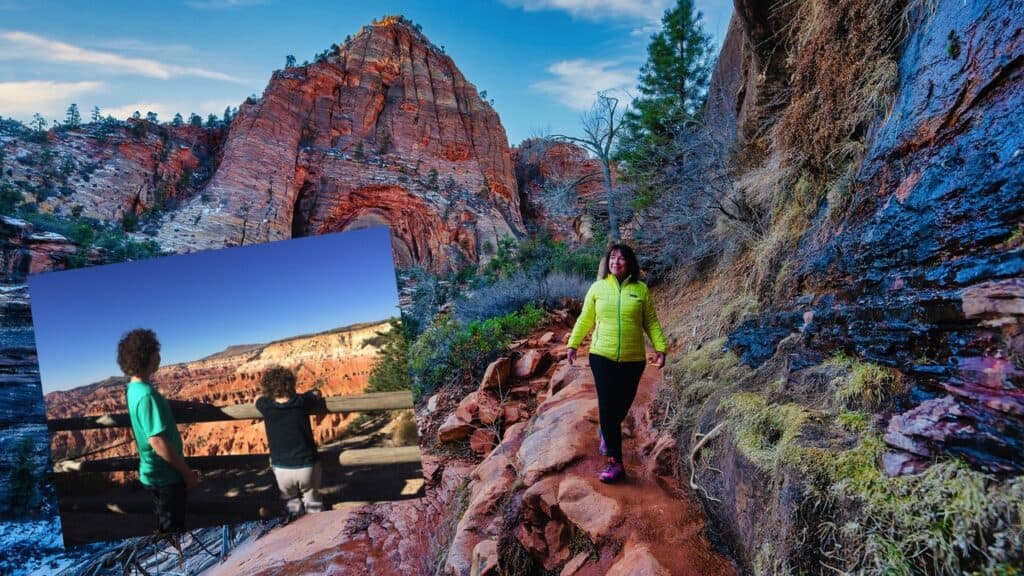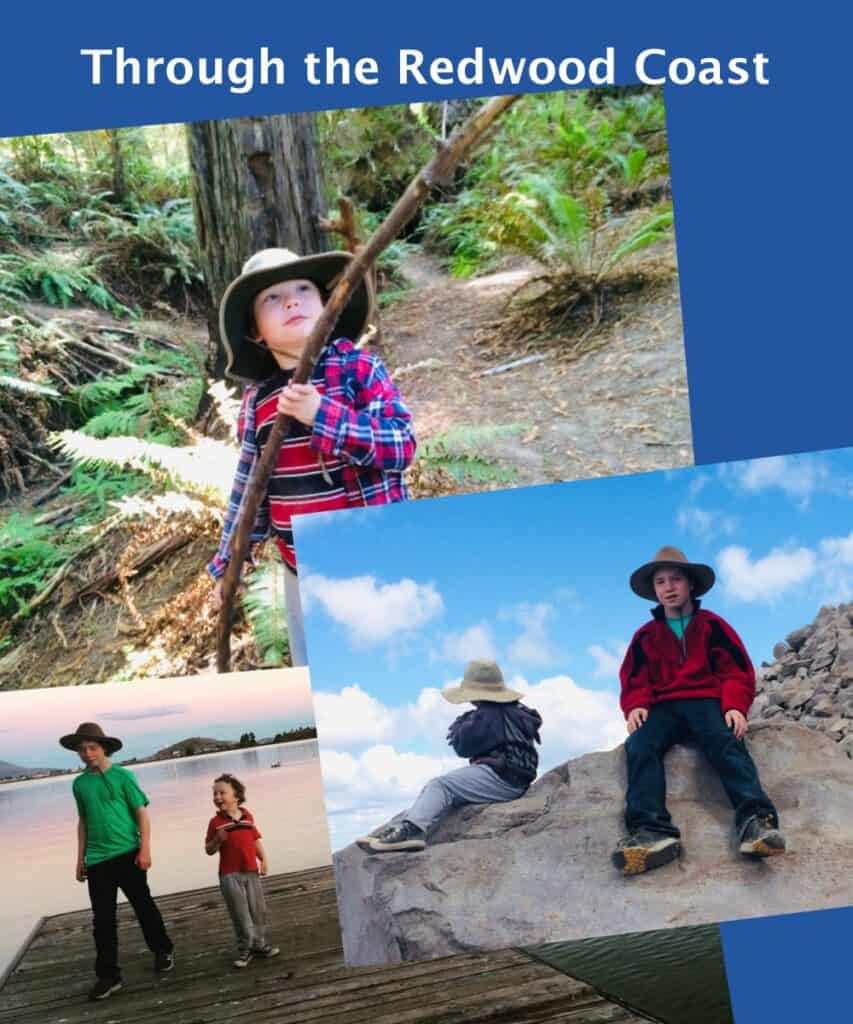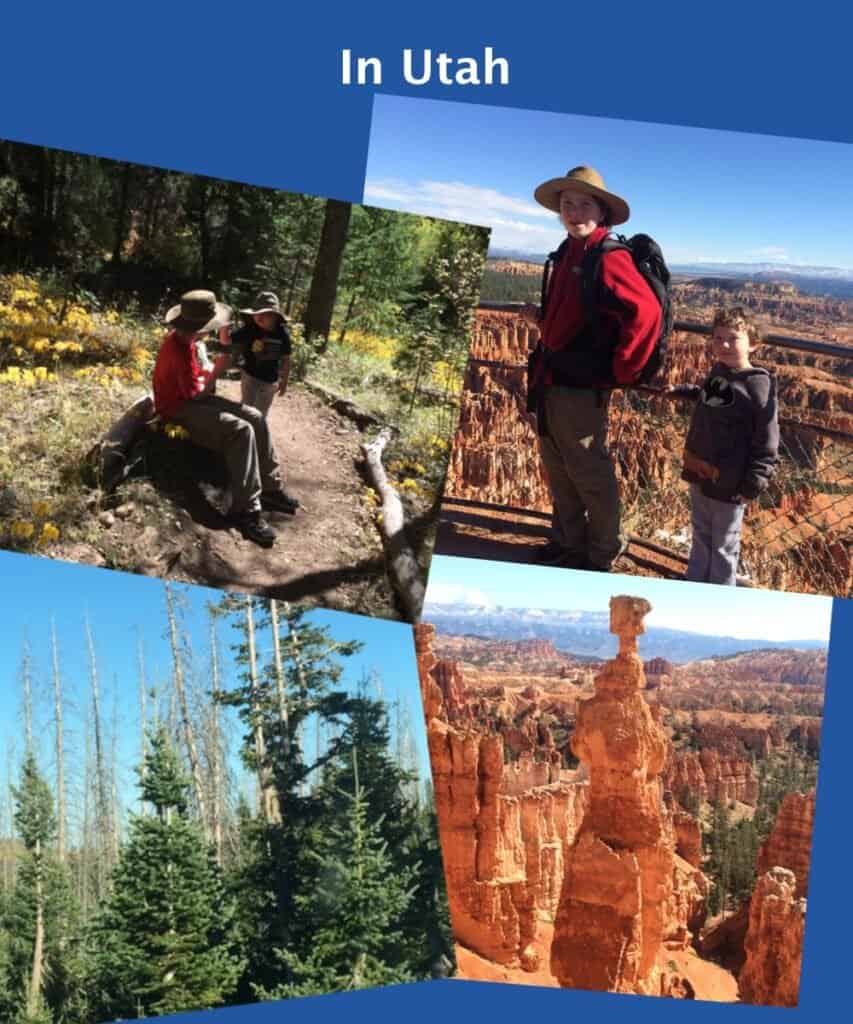A Postcard from Zion
A big part of my weight loss story is my “why” — I injured my knee, was limping around my house in the Giant Sequoia National Monument, and wanted desperately to get out and hike with my sons. I could see giant sequoia trees right out of window, like a living “vision board” reminding me of my deep desire.
That desire was so deep that it led me down a path in which I lost far more weight than I would have ever dreamed possible.
I started posting my eating on Facebook, along with my hiking stories, and people started losing weight and also getting out to hike, kayak, and ride horseback, often for the first time ever or for the first time in decades.
These days in the Eat Like a Bear community I refer to these sorts of goals as “The Big Goal.” I urge people to “picture yourself at the very finish line, not what you will look like, but what you will be doing. Live in that goal every single day!”
I’ve talked about “The Big Goal” for about two years, but it all struck me once again a few weeks as I hiked in Zion National Park and kind of blew my mind:
The Big Goal may be the most important thing we do here at Eat Like a Bear and it may be a key factor that is driving the life-changing weight loss we are seeing in the Eat Like a Bear community.
The Big Goal: Just More Exercise?
First, let me recognize that many people skimming these posts will see the Big Goal as awfully trite: “Get out and hike and lose weight!”
We’ve been told our whole lives that one of the reasons we struggle with weight is that we just don’t get out and do anything. So we’ve all tried exercise programs over the years that may help us trim up a bit.
I spent my high school days doing Jane Fonda workouts and they certainly did help, though I was still legitimately chunky. I worked out rigorously with a personal trainer in my late 20s and got to about 170, 30 pounds above my current weight. Jane Fonda and the trainer named Raul both helped, but neither got me where I am today, and so I do think the advice of “get out and move,” is likely overly simplistic.
There is something of deeper importance with “The Big Goal,” not simply: “exercise more.”

I have spent some years now reflecting back on my own goal and when that goal was seeded in me, and it was that point that hit me a few weeks ago at Zion National Park.
First, understand that all of these decades, I’ve never been a hiker.
It’s not as if I had hiked through my teens and twenties and strive to recapture some of the spirit of youth. Recapturing youth may drive the Big Goal of a whole lot of people, but that was not the case with me.
What makes a 48-year-old 280-pounder who’s never hiked suddenly desire to hike so badly that she makes a series of life-changing decisions leading to that hiking trail?
It happened in September 2016 on a trip to Utah to visit Zion, Bryce Canyon, and Cedar Breaks.
Searching for something
Way back in 2016, about 10 weeks prior to arriving in Zion, I started a big diet that lasted a day and a half. I started it on July 4, 2016 and by mid day July 5 I asked myself: “How are you going to maintain your weight loss this time???”
I was stunned because I had simply never asked myself that question. I decided to take six months to examine it. I was very much open to any sort of solution and I was definitely caught off guard with my lack of an answer.
That summer, I took my two boys on a trip through the coastal redwoods in Northern California, one of the handful of road trips the three of us had started to take. My sons were 8 and 14 at the time and specific medical reasons we had traveled very little together prior to this time. We were beginning to break out from that and I was juggling travel with two kids for the first time. Both kids were also homeschooled and I was determined to make something out of our new adventures, though those early trips were difficult as we worked through the logistics of travel — getting everyone fed and seeing sights that would appeal to two distinct age groups.

By September when we hit Utah’s Dixie National Forest and its impressive collection of national parks and monuments, we were just starting to find our groove with the travel. For one, we stayed in one location for a week and had a kitchen. We spent our days exploring, with sandwiches packed in the car. We landed back at the lodging late each day to our little kitchen and an easy plan for dinner. The day-to-day was simple and formulaic, we simply needed to add some adventure. We did just that.
Besides being completely blown away by the overall beauty and geology of southern Utah, it was a rich educational experience for us. Dixie National Forest had been devastated by the bark beetle some years before and had some fairly massive forest fires. Large stands of the forest were in various stages of regeneration in 2016. Back in our own home forest, the bark beetle had just hit and we were at the beginning of the devastating signs of high tree mortality. One month prior we had also been evacuated by the Cedar Fire, a forest fire that devastated the forest just to the south of us. We had arrived in Utah fairly sad about the state of our own forest, and we dug deep into the questions of regeneration. (As you may know, much of the rest of our forest has since been nearly completely burned.)
On the drives to Zion, Bryce, and Cedar Breaks, we drove through at least a decade of examples of regeneration — the early stages of complete forest fire devastation, early growth of smaller plants, the emergence of Aspen forests, and the regrowth of conifer trees under the canopies of larger Aspens.
With each new grove we found, the kids would have more questions. Over the course of the week, we stopped multiple times at the ranger station at Cedar Breaks asking yet another set of follow-up questions.
Looking back, it’s a bit comical. Those rangers must have thought they hit the jackpot with my inquisitive children.

Each of those days, as we drove past all of those Aspen groves, we took short hikes through Utah’s iconic federal lands. Typically, my older son would hike well ahead of us on the trail, and my 8-year-old and I would hang back and walk a half mile or so. He was young and I weighed about 260 pounds.
At each of these trails, my older son would urge us further. We did our best and I really did long to go further.
The overall experience of hiking on those trailheads in Utah and engaging with my sons in a deep educational experience hit all of my deep points as a mother.
(However, I am struck that for as impactful these trips were for our family, I have found few photos in the period of any of us smiling.)
Back nearly three months before I had asked myself what my key to maintenance would be and I still didn’t have an answer to the question as we drove to Utah.
However, exploring those regenerating forests, asking forestry questions of the rangers, and walking along those trailheads made me wonder:
“What if hiking is my key to weight maintenance? What if I just start hiking? What might happen?”
The Hiking Goal
And so I set my first hiking goal in my life and it was very simple: I set a goal to hike with my sons.
We visited Sedona for the first time that November. We hit all of the trails as best as each of us could.
In December we headed to Palm Springs for more hiking in Joshua Tree National Park. On our first day there, I tripped and fell and twisted my knee so badly that I ended up in the ER getting x-rays and I was laid up on the couch for some months.
Ripping That Goal Right Out From Under Me…
The peak of my own desperation was January 2017, topping the scale at 280 pounds and now not able to pursue that possible “key to maintenance” that I had identified in September in Utah.
In addition, those trip to Utah and Arizona really did give me the taste of something I had not experienced before. The knee injury ripped it right out from under me, making me extra-desperate for change.
I consulted with a bariatric surgeon in March 2017 and was approved for surgery by June.
It was a surgery I would never have and no longer qualify for, but (in an entirely other story) it positioned me into a psychology that led me right here, down 140 pounds, my lowest weight as an adult, and 40 pounds below the forecast of the bariatric surgeon.
My “Hiking” in 2017
As I look back on my “memories” in social media and in my collection of video clips and photos on my phone, I am struck by my commitment to my goal as I limped around at 280 pounds, then 270, and then 260 pounds, all through the spring and summer of 2017, landing me in Wyoming to observe the total solar eclipse and taking a rare full-body family vacation photo at Yellowstone National Park.
If you’ve missed that 2017 photo, it was the centerpiece of a 2018 video that largely shaped the culture and success rate of the Eat Like a Bear community.
As I look back on my hiking in 2017, I am struck by perhaps the key point in all of this: my goal had nearly nothing to do with the exercise.
I did not count my miles or heart rate or calories lost. This hiking was not some sort of fitness goal driven by the advice of a personal trainer. By then, hiking had become a symbol for me of engaging in a far more vibrant life with my family. The miles I might be able to hike might get me out there more, engaging more. The purpose of any additional miles was for additional engagement, not for an additional caloric deficit.
I did know that the hiking would surely help with my weight, and that if I could make it a habit, I could maintain my weight loss easier, but driving my new goal to hike had become far deeper for me than fitting in pants or wearing a size 14 (or an unimaginable size 8 or 10).
The Big Goal IS the Key to Maintenance
Years later, as I reflect back on my own experience, and as I see thousands of people in the Eat Like a Bear community engaging in many different ways in their own goals, I am struck again and again by the importance of what I now call “The Big Goal.”
When I am in a slump and struggling with overeating (or whatever other decisions might jeopardize my longer-term health goals), I “re-engage.” I very literally go on a hike or work hard on my own five acre property, in a beastly fashion like I could not do at 280 pounds.
I go out and work for ten hours, wearing out every single muscle group, and I reflect deeply on the point that I simply could not handle this sort of activity 140 pounds ago.
In so doing, I recommit and stay focused.
Food 5%; Psychology 95%
These days, you will hear me often say things like “this whole weight loss thing is only maybe 5% about the food.”
Yes, how we eat here at Eat Like a Bear is distinct and effective. You can jump in and learn it for free in the Three-Day Challenge.
What we eat is obviously a necessarily part of life-changing weight loss.
What we eat is necessary but it is not likely sufficient for long-term change and maintenance.
The key to maintenance may very well be a goal so big that it touches us deep in our hearts, in a way that a number on a scale never can.
The Big Goal is likely one that keeps us engaged with our new life every single day, reminding us of the importance of making daily decisions for our long-term interests — for our most vibrant life — foregoing the compelling short-term choices of the donut and the fries.
The Big Goal can drive more weight loss than you may even be able to imagine, but it may also drive that elusive long-term success we have all craved.
If you do not yet have a Big Goal, I urge you to make one. I expect you will need it one day.
